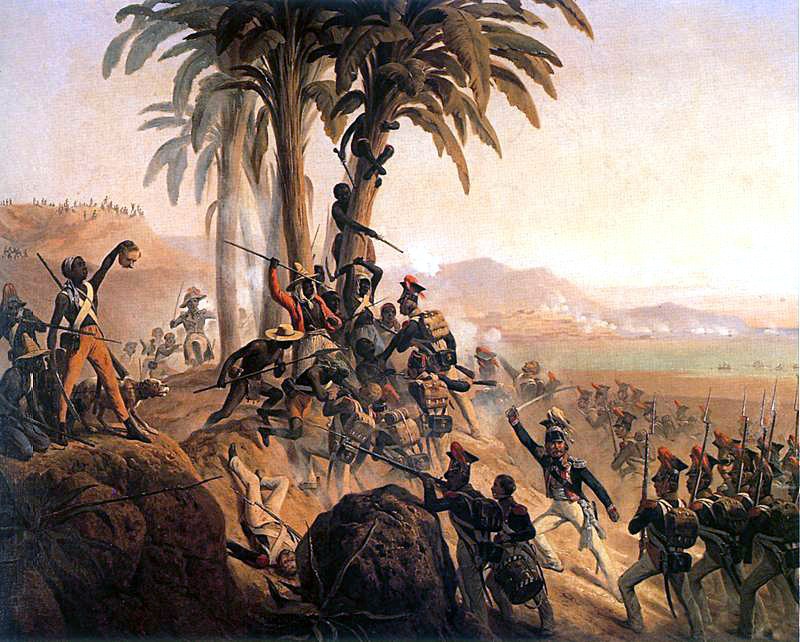The success of the American and the French Revolutions echoed through the people of the new and the old world. These events, powered by the Enlightenment ideas of popular sovereignty, individual freedom, and equality, proved that parting from powerful and oppressive rulers was possible.1 For the first time in recent history, the common man had united and fought for a republic based on the idea and practice of self-rule. This idea of fighting and revolting for independence traveled to slaves on the shores of a Caribbean island where the French had established the colony of Saint-Domingue in 1697.

Saint-Domingue was perhaps one of the most profitable lands that France had in its possession since it produced and exported coffee, indigo, tobacco, cotton, and sugar. The original aboriginal population of the islands had all but disappeared by the time the French had come to the island, and to make use of the colony, the French began to import slaves from Africa to work the fields. It is estimated that by 1789, the colony had a total of 500,000 African slaves, 35,000 white French settlers, and 50,000 colored freedmen who were French citizens and who also owned slaves.2 Despite slaves being the majority of the colony’s population, they lived under a strict and abusive social structure where they worked strenuous jobs under the threat of the whip, and would often starve to death. If runaway slaves were caught, they were often tortured and mutilated in order to dissuade other slaves that there was no escape from the chains of slavery. The daily life for the slaves of Saint-Domingue was one of fear and ill treatment.

French King Louis XIV established the “Code Noir” or Black Codes for the colony, which established rules for the treatment of slaves in all of its French American colonies. The code stated that slave owners were prohibited from sexually violating slaves or from torturing them, and they were required to provide food and clothes to the slaves. Nevertheless, slaves were regarded as property and could receive the death penalty if they did not comply with their masters.3
In 1788, fourteen slaves complained to the court that Nicolas Lejuene, a slave master’s son, would burn slaves alive, and although these acts were clearly violating the law, the courts and public opinion on the Island dismissed Lejuene and he was not prosecuted.4 This incident suggests that laws were not uniformly enforced in the colony, so masters had a free hand in their often atrocious treatments of their slaves. Many slaves ran away from their oppressive masters and hid in the mountains forming large communities of maroons. Their resentment to their French masters only escalated.5

With the ideas of political independence and social revolution circulating the world, slaves in the colony of Saint-Domingue were no longer willing to endure the treatment of their French masters. Tensions in the colony led to a violent uprising. The Haitian Revolution began in August 1791, when about 15,000 slaves destroyed and burned plantations and homes, and murdered white settlers in what was called the “Night of Fire.”6 This event encouraged the educated Catholic and former slave Toussaint L’Ouverture to join the cause. He helped train an army of 50,000 slaves in guerrilla warfare.7 The colony fell into chaos for years as the slaves revolted against French oppression in violent measures, and it was not long before the colony of Saint-Domingue was controlled by the slaves of the island.8

General L’Ouverture allied with the British in order to drive out the French settlers. But unwilling to let go of their colonial power, the French emancipated slaves in 1794; but they were still unable to secure and control the Haitian revolt. By 1803, L’Ouverture had proclaimed himself the governor of the colony, angering the powerful Napoleon Bonaparte who went after L’Ouverture, capturing and imprisoning him. This, however, did not weaken the resolve of the slaves to form an independent state. As Jean-Jacques Dessalines rose to power in the absence of Toussaint L’Ouverture, he ordered the gruesome execution of all Frenchmen in the colony. A year later, in 1804, Haiti was declared independent from French power.9
The slaves of Saint-Domingue were not expected to take on the example of the American colonies and the Enlightenment Era in order to fight for their independence. After the gory and terrible deaths of almost half the population in the colony–including French settlers, free black men and slaves–Haiti stood tall and free, shocking the world.10
- Jerry H. Bentley, Herbert F. Ziegler and Heather E. Streets-Salter, Traditions and Encounters: A Brief Global History Vol 2 (New York: MacGraw-Hill Education, 2016), 471. ↵
- Encyclopedia of Emancipation and Abolition in the Transatlantic World, 2007, s.v. “Haitian Revolution,” by Eugenio Matibag and Junius Rodriguez. ↵
- Philippe R. Girard, “Code Noir,” in Africa and the Americas: Culture, Politics, and History, no.1 (2008): 1. ↵
- Laurie M. Wood, “Across Oceans and Revolutions: Law and Slavery in French Saint-Domingue and Beyond,” Law & Social Inquiry 39, no. 3 (Summer 2014): 5. ↵
- Jerry H. Bentley, Herbert F. Ziegler and Heather E. Streets-Salter, Traditions and Encounters: A Brief Global History Vol 2 (New York: McGraw-Hill Education, 2016), 478-479. ↵
- The Black Past: Remembered and Reclaimed, 2007, s.v. “L’Ouverture Toussaint (1742-1803),” by Deborah McNally. ↵
- J. R. Beard, The Life of Toussaint L’Ouverture, the Negro Patriot of Hayti: Comprising an Account of the Struggle for Liberty in the Island, and a Sketch of Its History to the Present Period (Chapel Hill: University of North Carolina at Chapel Hill Library, 2012), 54. ↵
- Matt Clavin, “Race, Rebellion, and the Gothic: Inventing the Haitian Revolution,” Early American Studies, no. 1 (2007): 5. ↵
- Matt Clavin, “Race, Rebellion, and the Gothic: Inventing the Haitian Revolution.” Early American Studies, no. 1 (2007): 2. ↵
- Matt Clavin “Race, Rebellion, and the Gothic: Inventing the Haitian Revolution.” Early American Studies, no. 1 (2007): 5. ↵



70 comments
Alejandro Fernandez
In the article “Slave Revolt: the Creation of Haiti,” the author provides context of the Haitian Revolution and its overall importance to today’s society. Specifically, one interesting fact the author provides about the Haitian Revolution is its relation to both the American and French Revolutions. Essentially, the Haitian’s acquired their bravery through the influence of American and French independence. This particular note is one that speaks volumes as it serves as a reminder that certain historical events carry importance and will continue to do so in the future.
Eugenio Gonzalez
The article was very informative. Prior to reading the article, I did not know about the slave revolt in Haiti. It was interesting to learn about the Code Noir, which protected the identity of enslaved people. Even though Code Noir existed, it was not enforced, and many enslavers got away with many terrible actions. Overall, the article is well-written and has a compelling narrative.
Jacob Salinas
This was a very interesting article to read. This article gave me an insight in to how brave these slaves in Haiti were. It is remarkable that they got the courage to revolt against the French soldiers. Before reading this article, I knew very little of the Haitian slave revolt. The author did this story justice by telling a very compelling story that made it easy to follow along. This article was also very informative.
Noelia Torres Guillen
Thank you for this informative article on the Haitian Revolution. I knew very little about the revolution, only that slaves got freedom though violent means in order to be rid of the French and their terrible treatment. I had no clue that there were laws in place that prohibited torturing slaves and this is because slave owners tortured them regardless. I love how slaves took matters into their own hands and since they were a large colony they were able to succeed and become independent from the French.
Anna Steck
This was a very interesting and well written article. It was a very clear narrative style and stuck to the point of the revolt. I would love to hear more about Toussaint L’Ouverture and his motivations, but you pointed out some other reasons that the slaves revolted and won. First was that their treatment was absolutely intolerable despite the laws that were supposed to protect them from torture. Second was their sheer number over the white colonists. Loved the article!
Jacob Adams
I knew very little of the Hatian revolution before I read this, you did an excellent job of presenting the historical context and the research involved in discussing the Haitian Revolution. The ideas of popular sovereignty, individual freedom, and equality which was inspired by the American and French revolutions which led to the idea of fighting and revolting for independence. You highlighted the social structure of Saint-Domingue and the Code Noir that controlled the lives of the slaves there. I found it interesting how you also highlighted the fact that the Haitian Revolution was not expected, yet it brought about significant change to that part of the world. The sources and pictures throughout were relevant and kept me engaged with the reading.
Christopher Morales
This story showed the struggle of slaves at this time in detail. It was not only the bad treatment, but the unfair representation in court, and the lack of laws to protect them were not being enforced. You told this story very good, and it really intrigued me as I started to rally behind the slaves. It is interesting to see how an event around the world could create the motivation for these people to see their strength and possibility of revolting. I am happy they were able to occupy the land. It is an important part of history that reflects hope and justice.
Barbara Ortiz
I really enjoyed reading your article. I found it interesting that of all the areas of the world, that the Haitian Revolution would actually stand and win their independence. I wonder how it was that no other colony of slaves was able to accomplish such a feat. I wonder if the American war of independence and the French Revolution had not occurred during just before this revolt, would it have even occurred at all?
Adelina Wueste
This article had so much good information! I just recently learned about the slave revolt in Haiti, but I did not know about so many of the details. I had assumed that the slave population in Haiti was large, but I had no idea that the slave population was so big in comparison to the French. Aside from the large population of slaves in Haiti I did not know about the Code Noir. Despite the Code Noir being in place to protect slaves, it is not surprising that it was not followed.
Jose Maria Gallegos Cebreros
Hi Ana, first of all I really enjoyed reading your article, it was very informative! I think everyone has ever heard about Hispaniola but you provided me a lot of information I did not know about. Haiti has a lot of history that not many people know about and it has an amazing culture as well. It was a very easy article to digest!